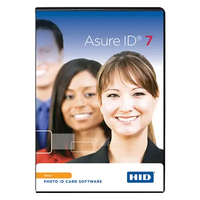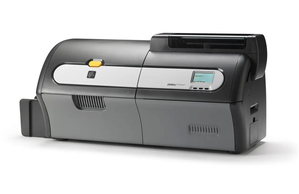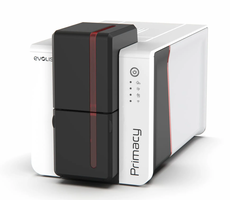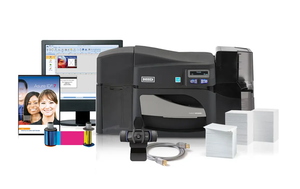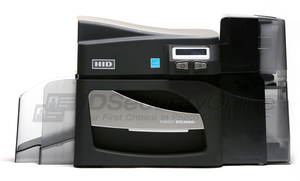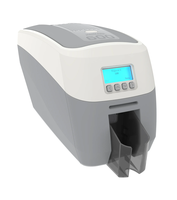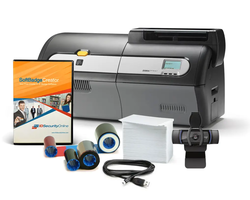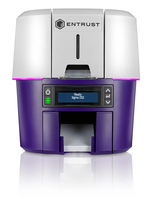ID Card Applications
Getting your own ID card system allows you to do way more
than issuing identification badges.
Turn your cards into powerful tools by
learning how to issue ID cards, access control badges, loyalty cards, payment
cards and membership IDs.
Identification
Having your own ID card system allows you to issue professional ID cards for your employees, students or visitors and identify at a glance who should be in your facility... and who should not.
Photo ID badges
Basic photo ID badges typically feature the name and logo of the organization, a background or image and the cardholder’s information with a photo ID. Any card printer will allow you to create these types of badges.
The great benefit of creating your own badges is that you can personalize your cards based on your requirements. You can add an ID number, signature area, expiration date, or emergency contact information.
ID badges are now standard security tools in many industries such as schools, businesses, healthcare facilities, government offices, retail stores, or event facilities.
Advanced options
Several options are available to embed data into your cards. The easiest – and most affordable – solution is to add a barcode. No need for a specific encoder: all you have to do is add it in the design of your cards.

Student ID with magnetic stripe
For advanced functionalities, print and encode magnetic cards. Widely used in access control and time & attendance, magnetic cards are an affordable choice for your badges.
If you want highly secure badges, opt for smart cards. With contact and contactless smart cards, the data is securely encoded into an embedded chip. To store data and to be read, a contact smart card must be inserted into a reader, when contactless smart cards only need to be waved within range of a reader. Perfect for student IDs, healthcare cards, loyalty cards or government IDs, smart cards can now easily be created with a card printer with smart card encoder.
Evolis Primacy 2 Dual Sided ID Card Printer
Access Control
Create your own access control badges to secure your premises and keep everyone safe. Card-based access control systems are effective solutions for office buildings, schools, government facilities, and event venues.

Healthcare access card with magnetic stripe
Limit access to high-security areas of your premises by issuing ID badges that will be swiped or waved in front of a reader. Magnetic cards are a popular choice as they are affordable and easy to set up. You can personalize the front of the card with the cardholder’s information and encode the magnetic stripe with access data.

Access card with smart contact chip
For higher levels of security, choose smart cards. With contact and contactless smart cards, the data is securely encoded into an embedded chip. To store data and to be read, a contact smart card must be inserted into a reader, when contactless smart cards only need to be waved within range of a reader.

QuickShip Proximity card waved at a reader.
Another option is proximity cards. Proximity cards are read-only devices that have an embedded antenna. The cardholder data can be read when the proximity card is passed within range of a reader. The range of operation for proximity cards varies typically from 2.5" to 20" (63.5 mm to 508 mm) depending on the reader.
IDSecurityOnline offers its own line of Proximity cards called QuickShip. QuickShip proximity cards feature the exact same specs as HID cards but ship within 2 business days, which is 4 times faster than for HID.
Fargo DTC4500e Double Sided Photo ID System
Asure ID Express 7 Software - Digital Delivery
Fargo DTC4500e Single Sided ID Card Printer Dual-Input Card Hopper
Loyalty
Issuing loyalty cards goes a long way to improve customer satisfaction and retention. Affordable and easy to use, loyalty cards help strengthen the relationship that a retailer has with its customers. In the process, the retailer gets key information about the profile of its buyers: who they are, what they buy, when they visit a store, etc. This data can be used to segment marketing actions and send targeted communications to clients. In exchange, the customers’ loyalty is rewarded through discounts, gifts and special promotions.
Gift cards have also become extremely popular. They encourage people who might not visit your business to take a look around and likely return to make additional purchases. Gift cards are great to develop your brand’s awareness and make customers try your products.
You can also create very special cards and customize them with the recipients’ names for a unique experience.
Magicard 600 Dual Sided ID Card Printer
Fargo DTC4500e Double Sided Photo ID System
Payment
Turn your ID cards into cashless payment options. Magnetic cards are widely used to process payments and securely store data on a card. They can even be personalized onsite, which allows you to issue a payment card within minutes. A decentralized process will reduce your costs — no need to mail cards — but also improve your customer’s experience by allowing immediate use of the card.
If most banks are still using magnetic cards, a lot of them are now switching to smart cards as they offer higher levels of security and efficiency. Contactless smart cards can be read by simply waving them in front of a reader, which would significantly streamline the payment process. The right ID card system can encode and print highly secure cards at an affordable price point.
The development of these technologies allows retail shops to create store cards that serve as loyalty and payment cards. Issuing payment cards is no longer reserved for financial institutions. A coffee shop, clothing store or beauty salon can now produce personalized ID cards for multiple applications and manage their whole system onsite.
Zebra ZXP Series 7 Dual Sided ID Card System
Membership
Membership cards are great to identify people who are entitled to special privileges and build solid relationships with your customers.
You can issue visual IDs to identify your members at a glance and/or encode cards with the cardholder’s data. Add a barcode to scan each card and grant access to members or opt for magnetic cards if you have an access system in place. When crowd control is an issue, smart cards help you streamline access and reduce wait lines.
Membership cards also allow you to capture valuable customer data for marketing purposes. You can then create targeted campaigns and promotions for segmented groups of customers. Not only will your clients feel special but you will also increase the sense of community among your members.
For advanced features, choose smart cards. With contact and contactless smart cards, the data is securely encoded into an embedded chip. To store data and to be read, a contact smart card must be inserted into a reader, when contactless smart cards only need to be waved within range of a reader.



